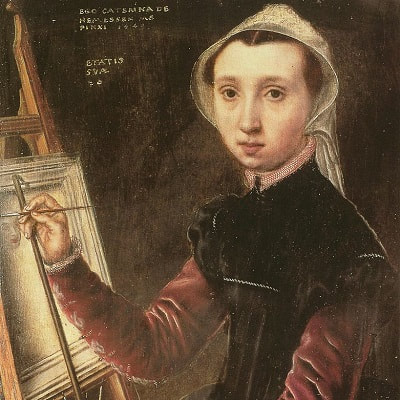Who is Van Hemessen? Caterina van Hemessen (c. 1528 – c. 1588) was born in Antwerp, the second of two daughters. The city was one of the leading art centers of Europe at the time. She would have been a contemporary of Pieter Bruegel the Elder and Frans Floris. Her father, Jan Sanders van Hemessen (1500–1566), was a Flemish Renaissance painter who is considered the inventor of Flemish genre paintings (the portrayal of people engaged in everyday activities). He had been to France and Italy in the 1520s and must have been affected by all that he learned while there. It is assumed that he taught his daughter to paint, and his influence may have been the reason she felt she could paint herself and reveal what she was capable of doing with paint and brushes. Caterina collaborated with her father on some of his paintings, and she herself specialized in portraits of wealthy men and women. She also produced religious art, and there are nine portraits and four religious works attributed to her today.
The majority of her portraits are realistically painted against a neutral or dark background, as was the custom. Her focus was to capture their facial features without reference to surroundings in time or space, and each was small in size, on average, 30 x 20 cm.
Following in her father's footsteps, she became a member of the Guild of St. Luke and had three male students of her own. In 1555, she is recorded as a maid of honor in the official lists of the Brussels Court of Mary of Hungary. Giorgio Vasari included her in his book Lives of the Most Excellent Painters, Sculptors, and Architects (1568) with the Flemish painters.
Works of Caterina van Hemessen?
The majority of her portraits are realistically painted against a neutral or dark background, as was the custom. Her focus was to capture their facial features without reference to surroundings in time or space, and each was small in size, on average, 30 x 20 cm.
Following in her father's footsteps, she became a member of the Guild of St. Luke and had three male students of her own. In 1555, she is recorded as a maid of honor in the official lists of the Brussels Court of Mary of Hungary. Giorgio Vasari included her in his book Lives of the Most Excellent Painters, Sculptors, and Architects (1568) with the Flemish painters.
Works of Caterina van Hemessen?

